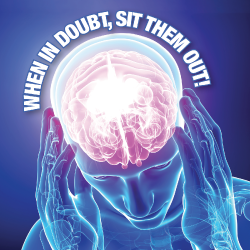
When in Doubt, Sit Them Out!
Addressing return to play protocol for concussions is a prudent practice for organizations that are practicing active risk management. Let’s review the basics of return to play as published by the Center for Disease Control.
First, athletes should only return to play after being medically released to participate by their Heath Care Provider, not the player, not a parent, not a coach, not an official! This provider should be experienced in evaluating and managing concussion. This release should be a written release. The steps to return to play are a gradual process. If any symptoms return during the return to play, athletes should stop until all symptoms are gone, and then start over with Step 1:
“BASELINE: Athletes should not have any concussion symptoms. Athletes should only progress to the next step if they do not have any symptoms at the current step.
STEP 1: Begin with light aerobic exercise only to increase an athlete’s heart rate. This means about 5 to 10 minutes on an exercise bike, walking, or light jogging. No weight lifting at this point.
STEP 2: Continue with activities to increase an athlete’s heart rate with body or head movement. This includes moderate jogging, brief running, moderate-intensity stationary biking, moderate-intensity weightlifting (reduced time and/or reduced weight from your typical routine).
STEP 3: Add heavy non-contact physical activity, such as sprinting/running, high intensity stationary biking, regular weightlifting routine, non-contact sports specific drills (in 3 planes of movement).
STEP 4: Athlete may return to practice and full contact (if appropriate for the sport) in controlled practice.
STEP 5: Athlete may return to competition.
If an athlete’s symptoms come back or she or he gets new symptoms when becoming more active at any step, this is a sign that the athlete is pushing him or herself too hard. The athlete should stop these activities and the athlete’s health care provider should be contacted. After more rest and no concussion symptoms, the athlete should begin at the previous step.” (CDC Heads Up Concussion in Youth Sports, 2017)
Red Flags: Below is a list of issues that you should be sensitive to:
- Parents try to release the child, rather than a medical provider. Let’s face it, some parents are pretty intense. Allowing a concussed athlete to play can be fatal. Only accept a written release from the athlete’s medical provider, one who is experienced in evaluating and managing concussions.
- Athlete just doesn’t seem right. This is a sign the symptoms might not be gone and the athlete is “under” reporting them. These signs might be mood swings, personality changes, moving clumsily, or can’t recall some items they should be able to remember. A full list can be found on our website, just login at trustedcoaches.org.
- A big game or tournament is in the near future: Parents, friends, and even grandparents can put pressure on an athlete to be in the game. Concussed athletes recover at different speeds, don’t rush them because of a big game.
Remember to always let common sense prevail. When in doubt, sit them out!
